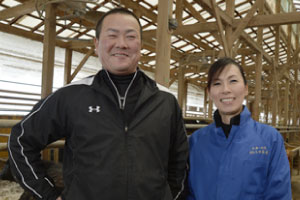- From breeding to fattening—the strength of integrated management
- Kami Town in Mikata County is an area in Hyogo Prefecture that is known for its heavy snowfall. It is in this town that Shinya Ueda runs an integrated cattle breeding and fattening operation. He tells us, “Our parents’ generation could not make a living on livestock farming alone and it was normal for them to go and work elsewhere during the winter. So I was determined to become a farmer that could live on just cattle.” True to his word, Ueda has successfully expanded his cattle business over the past 20 years.
Cattle breeders inseminate their cows to produce calves, which they raise for 9 months before putting them up for sale at auctions. Cattle fatteners buy calves from the market and raise them until they are 28 to 32 months. Because of the different skills required, many farms specialize as either a breeder or a fattener. But about 6 years ago, Ueda, who had inherited his grandfather’s breeding farm, began engaging in the fattening too. It was Ueda’s unyielding spirit that made him start. He says, “I wanted to raise ‘dropout’ calves that could not find any buyers in the market and turn them into good beef cows.” Of the roughly 220 calves that are born on his farm every year, Ueda now keeps all the female calves for fattening. - Calf’s stomach development is the key
- It is said that the key challenge for raising good cattle is having the animal develop a strong stomach so they can eat a lot of feed. On this point, Ueda Farm has an advantage because it can start working on the calves’ stomach immediately after they are born and spend plenty of time on the work. After much trial and error, the farm established its feeding management system and the effort is starting to produce remarkable results. The cow that received the 2013 Distinction Award was also born and raised on Ueda’s farm and was one of the best cows he had ever produced. Ueda says with a smile, “The cow was small and unimpressive when it was a calf. So it is a perfect example of a stomach development gone well. The cow responded to our efforts.”
Ueda once used to travel across Japan as a cattle hoof trimmer. He says he learned a lot from observing good stock farms around the country, from cattle raising techniques to management skills. He says, “Cattle farming techniques are evolving every year. It’s no good sticking to one method. We have to think flexibly and put out our antenna in search of new information.” - Family and staff working as one to advance to the next stage
- Ueda has 4 staff members supporting him. One of them is his wife Miyuki, who also serves as the head of the farm. Miyuki quit her job at a bank and married Ueda, despite objections from all her relatives. Ueda told her that he loves cows and cows are everything to him. Miyuki decided to work with Ueda to make his dream come true. Miyuki says, “Being a cattle farmer is harder than I had imagined. We have no holidays, for example. It’s not the kind of work you can do out of a sense of duty. You need to want to do it or like doing it.”
Ueda’s family and staff are now working together to make a transition to a “fully integrated management”, which means carrying out the fattening of all cattle born on the farm regardless of sex. Their challenge is drawing attention around Hyogo Prefecture.
 A sturdy mature cow affectionately snuggles up to Ueda
A sturdy mature cow affectionately snuggles up to Ueda

 Ueda and his wife often eat Kobe Beef themselves. They say, “It has a delicate, light, but deep taste. Kobe Beef is totally different from other beef.”
Ueda and his wife often eat Kobe Beef themselves. They say, “It has a delicate, light, but deep taste. Kobe Beef is totally different from other beef.”












![[Ueda Farm]Shinya Ueda](img/2013-04.gif)